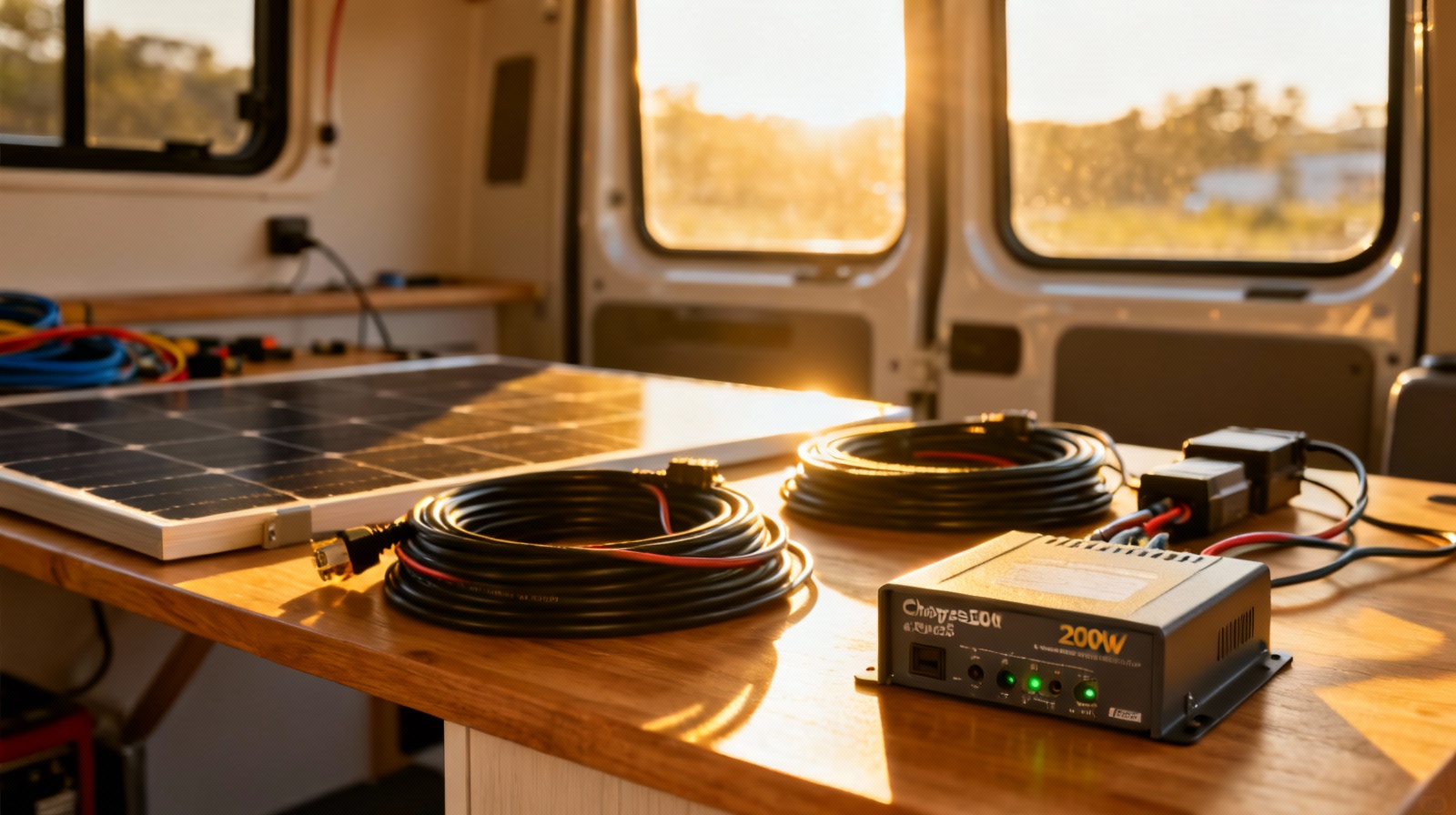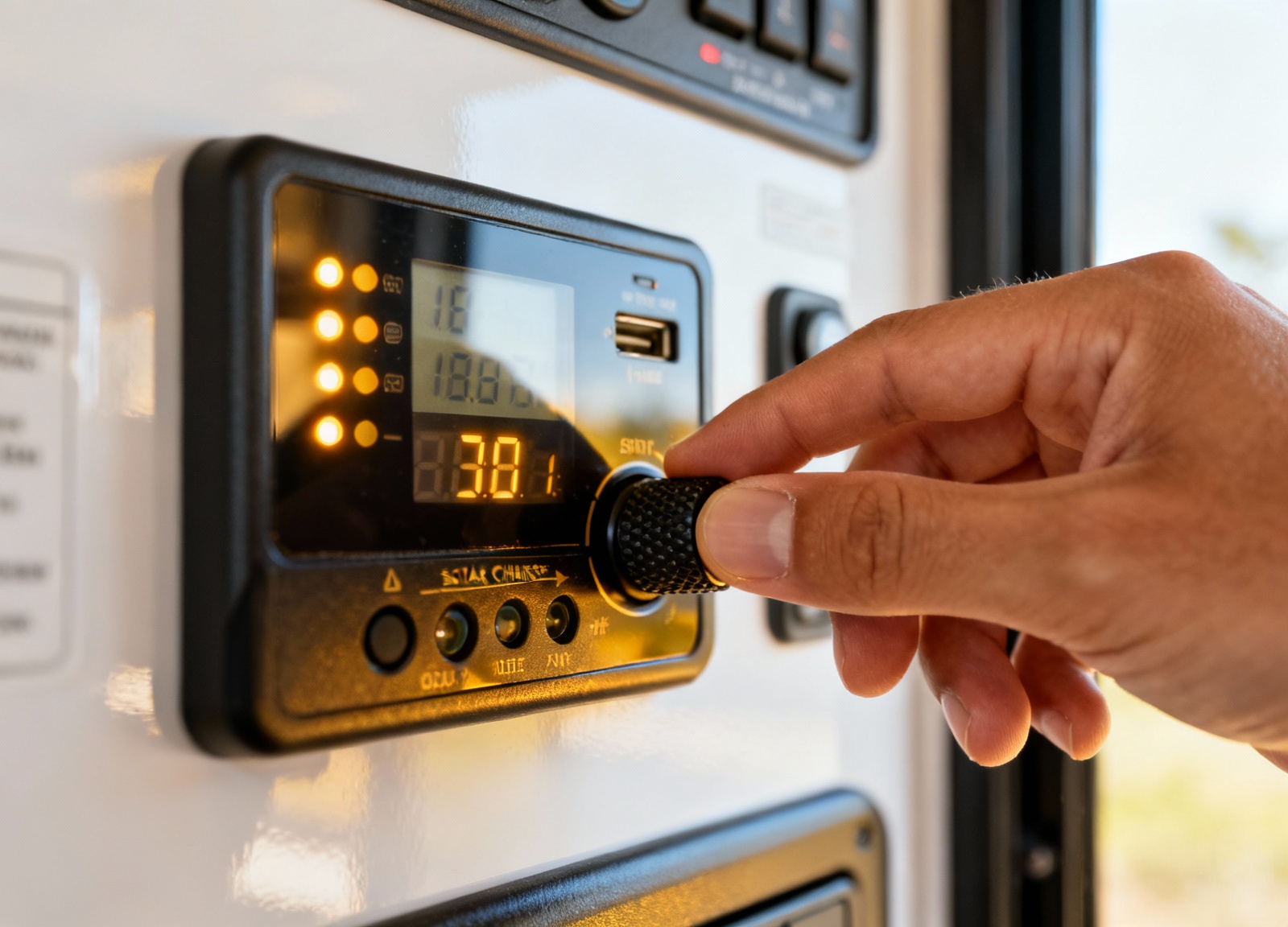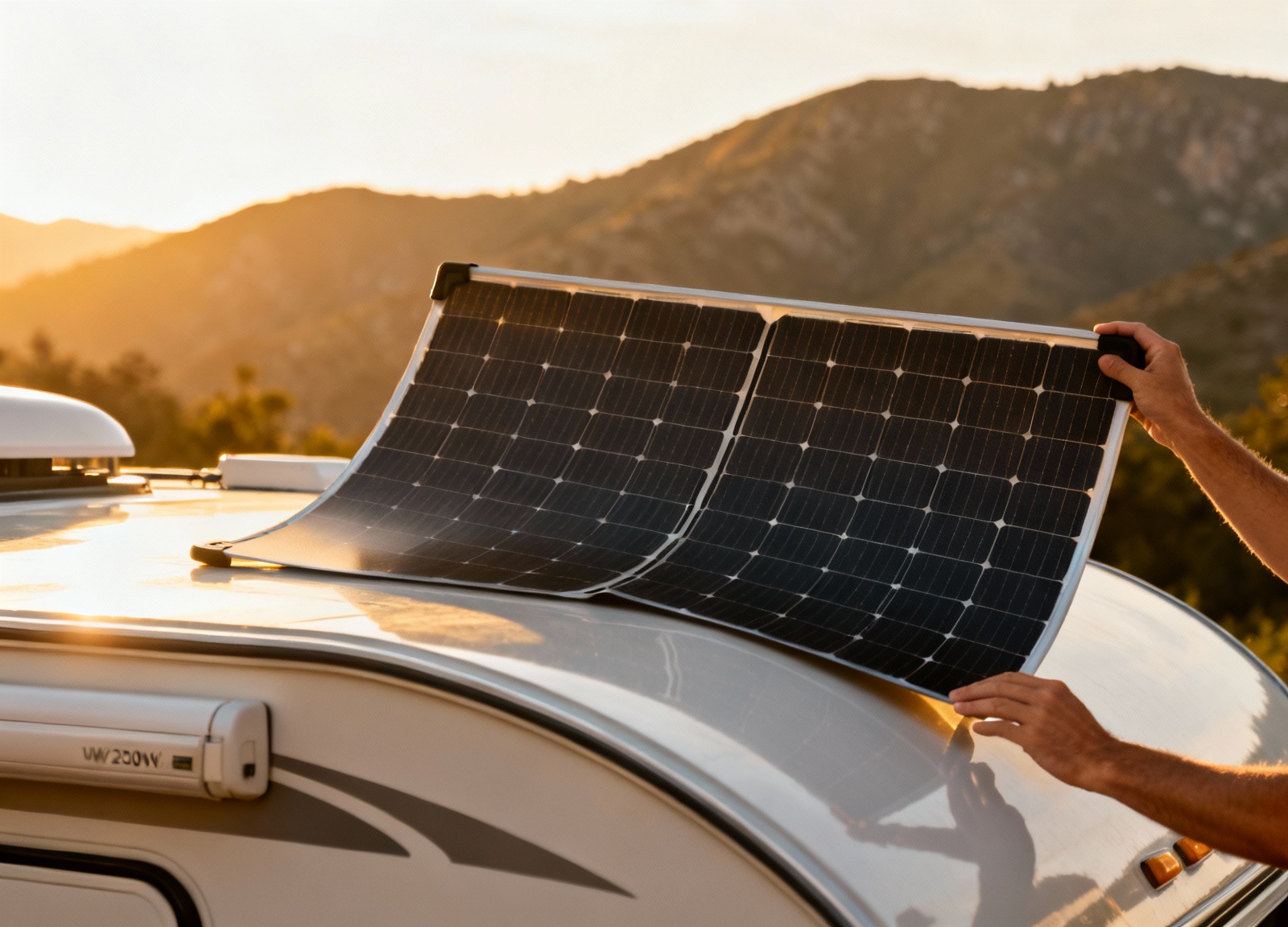
As an Amazon Associate, we earn from qualifying purchases.
Best by Use-Case
Boondocking
For extended off-grid camping, the Renogy 200W monocrystalline kit paired with a Battle Born 100Ah lithium battery delivers reliable power for 5-7 days without shore hookups. This combination handles essential loads like LED lighting, water pump, fan, and device charging while maintaining 50% depth of discharge for battery longevity.
The monocrystalline panels perform well in partial shade conditions common in forested campsites, producing 800-1000Wh daily in summer conditions. View on Amazon
Power management becomes crucial when boondocking. The 200W panel typically generates peak power between 10 AM and 2 PM, tapering off significantly in morning and evening hours. Smart boondockers align heavy power consumption with peak generation times, running water pumps for showers, charging laptops, and filling water tanks during midday sun. This synchronization reduces battery cycling and extends component lifespan.
Temperature significantly impacts both panel output and battery charging. Monocrystalline panels lose approximately 0.4% efficiency per degree Celsius above 25°C, meaning desert boondocking in 40°C heat reduces output by 6-8%. Conversely, cold temperatures improve panel voltage but require charge controllers with temperature compensation to prevent battery damage. The Battle Born lithium batteries maintain consistent performance from -4°F to 140°F, unlike lead-acid alternatives that lose 50% capacity at freezing.
- Pros: 10-year battery lifespan, consistent power in variable conditions, handles 1200W inverter loads
- Cons: Higher initial investment ($900-1200 for battery alone), requires MPPT controller upgrade for optimal winter performance
Budget Weekender
The Renogy 200W polycrystalline panel kit offers exceptional value for occasional weekend trips, providing enough power for basic needs at under $400 complete. This setup charges phones, runs LED lights, and powers a small 12V cooler for 2-3 day trips.
The included PWM controller and mounting hardware make installation straightforward, though efficiency drops 15-20% compared to monocrystalline options. Perfect for RVers testing solar before committing to premium systems.
Weekend warriors typically consume 300-500Wh daily, well within this system’s capability during favorable conditions. The polycrystalline technology uses multiple silicon crystals, creating a distinctive blue speckled appearance and slightly lower efficiency than single-crystal monocrystalline panels. This efficiency gap narrows in diffused light conditions, making polycrystalline surprisingly competitive on overcast days.
The included 20A PWM controller handles system expansion up to 400W total. However, PWM technology simply connects and disconnects panels rapidly to regulate charging, wasting excess voltage as heat. When panels produce 18V but batteries need 14V, PWM controllers discard the difference. This limitation becomes pronounced in cold weather when panel voltage increases, potentially wasting 30% of available power.
- Pros: Complete kit under $400, simple PWM controller for beginners, adequate for minimal power needs
- Cons: Lower efficiency in cloudy conditions, limited expansion capability, PWM controller wastes 10-30% potential power
Winter Camper
Cold-weather camping demands the Victron SmartSolar MPPT controller paired with high-efficiency monocrystalline panels. This combination extracts 25-30% more power during short winter days and low sun angles.
The MPPT technology adjusts voltage continuously, capturing energy even in rapidly changing cloud conditions. Temperature compensation prevents overcharging in freezing conditions while Bluetooth monitoring lets you track performance from inside your warm RV. View on Amazon
Winter solar presents unique challenges beyond reduced daylight hours. Snow accumulation blocks panels entirely, but even frost formation can reduce output by 25-40% until it melts. The steep sun angle in winter means panels mounted flat on RV roofs operate at perhaps 40% of their summer efficiency. Tilting panels toward the winter sun angle (your latitude plus 15 degrees) can double power production, making adjustable mounts particularly valuable for seasonal campers.
MPPT controllers shine in winter by converting excess voltage to additional charging current. When cold panels produce 22V but batteries need 14.4V, MPPT controllers transform that extra voltage into increased amperage rather than wasting it as heat. This voltage conversion becomes even more critical with series-wired panels producing 40V or higher.
- Pros: Maximum power harvest in low-light conditions, temperature compensation protects batteries, remote monitoring via smartphone
- Cons: Controller alone costs $150-250, requires careful wire sizing for cold weather voltage increases
Lightweight Setup
Go Power’s 200W portable folding kit weighs just 20 pounds and sets up in minutes, ideal for small trailers or van conversions where roof space is limited. The briefcase-style panels store inside during travel and deploy quickly at camp.
Built-in charge controller and battery clamps eliminate complex wiring. This flexibility suits renters or those frequently switching between RVs.
Portable panels offer surprising advantages beyond installation simplicity. Parking your RV in shade while positioning panels in sun keeps interior temperatures manageable without sacrificing power generation. The ability to track sun movement throughout the day—adjusting angle every 2-3 hours—increases daily harvest by 20-30% compared to fixed flat mounting. Some users report 1200Wh daily production from 200W portable panels through diligent repositioning, matching the output of 250-300W fixed installations.
Security remains the primary concern. The 25-foot cables included with most kits limit placement options, often requiring panels to remain within sight. Cable extensions introduce voltage drop, reducing charging efficiency. Many users secure panels with bicycle locks when stepping away briefly, though theft risk makes unattended deployment inadvisable in public campgrounds.
- Pros: No roof penetrations required, adjustable positioning maximizes output, transfers between vehicles easily
- Cons: Must be stored securely when driving, vulnerable to theft if left unattended, higher cost per watt than fixed panels
Quick Comparison

| Model | Type | Key Specs | Best for |
|---|---|---|---|
| Renogy 200W Mono Kit | Fixed Monocrystalline | 21.6% efficiency, 10.54A current, 25-year warranty | Full-time boondocking |
| Renogy 200W Poly Kit | Fixed Polycrystalline | 17% efficiency, 10.8A current, PWM controller included | Budget weekend trips |
| Go Power 200W Portable | Folding Monocrystalline | 20 lbs, built-in controller, 18.9V output | Small RVs, rental units |
| HQST 200W Kit | Fixed Monocrystalline | 19.8% efficiency, corrosion-resistant frame, MC4 connectors | Coastal/humid climates |
| BougeRV 200W Flexible | Flexible Monocrystalline | 4.4 lbs, bendable 30°, 0.08″ thin | Curved roofs, Airstreams |
Buyer’s Notes

A 200-watt solar setup represents the practical minimum for meaningful RV power independence, generating 800-1200 watt-hours daily under good conditions. This covers essential 12V systems but won’t run air conditioning or high-draw appliances.
Panel efficiency varies significantly between technologies. Monocrystalline panels achieve 19-22% efficiency and perform better in heat, while polycrystalline options hover around 15-17% but cost 20-30% less. The efficiency difference becomes critical when roof space is limited—common in Class B vans or small trailers where every square foot matters. A 200W monocrystalline panel measures approximately 59″ x 27″, while achieving the same output with polycrystalline requires 10-15% more surface area.
Controller selection impacts system performance more than many realize. PWM controllers included in budget kits work adequately for small systems but waste significant power when panel voltage exceeds battery voltage. MPPT controllers cost $100-300 more but harvest 20-30% additional power, especially valuable during winter months or partial shading. The payback period for MPPT upgrade typically runs 18-24 months for full-time RVers.
Battery pairing determines usable power. A 200W panel charges a 100Ah lead-acid battery in 5-7 hours of peak sun, but you should only discharge to 50% capacity, yielding 600 watt-hours usable power. Lithium batteries discharge to 80-90%, providing nearly double the usable capacity at half the weight. While lithium costs 3-4 times more initially, the 5,000+ cycle lifespan versus 500 cycles for lead-acid often justifies the investment for frequent boondockers.
Installation complexity varies by kit type. Fixed panels require roof penetrations, sealant expertise, and potential warranty concerns on newer RVs. Professional installation runs $500-1000 but ensures proper waterproofing. Portable panels avoid roof work but require secure storage and daily setup. Many RVers start with portable systems to determine power needs before committing to permanent installation.
Wire sizing critically affects system performance. Undersized wiring creates resistance that manifests as heat and voltage drop, reducing charging efficiency and potentially creating fire hazards. A 200W system pulling 11 amps requires minimum 10AWG wire for runs up to 15 feet. Longer runs demand 8AWG or larger to maintain voltage drop below 3%. Every connection point introduces additional resistance, making quality MC4 connectors and proper crimping essential.
Shading impacts deserve special consideration when planning panel placement. Even partial shading of one cell can reduce entire panel output by 50-75% due to how cells wire in series internally. Tree branches, air conditioner units, or even accumulated leaves create power-robbing shadows. Some panels include bypass diodes that minimize shading impact by routing current around affected sections, though output still suffers significantly.
Safety

Solar installations involve both electrical and structural safety considerations. Improper wiring can cause fires, while poor mounting may lead to panels detaching during highway travel.
Always install appropriate fusing between panels and charge controller (typically 15-20A for 200W systems) and between controller and battery (25-30A). Use marine-grade wire rated for outdoor exposure and size cables appropriately—10AWG for runs under 15 feet, 8AWG for longer distances. Voltage drop exceeding 3% reduces charging efficiency and generates heat. Mount the charge controller within 6 feet of batteries when possible, using the shortest practical cable run to minimize resistance losses.
Roof mounting requires careful attention to structural integrity. Locate rafters using a stud finder before drilling, avoiding areas near existing penetrations or tank vents. Apply Dicor or similar RV-specific sealant liberally around all penetrations, checking annually for cracks or separation. Use stainless steel hardware with rubber washers to prevent corrosion and leaks. In high-wind areas, add additional mounting points—standard kits often include just four corners, but six-point mounting prevents flexing that can crack panels.
Electrical safety extends beyond installation. Never connect or disconnect panels under load, as DC arcing can damage connectors and create fire hazards. Cover panels with blankets during wiring work to prevent shock—even 200W panels produce enough current to cause injury. Install a DC disconnect switch between panels and controller for emergency shutdown and maintenance access.
Ground fault protection becomes critical in wet conditions. While not required by code for 12V systems, adding a ground fault circuit interrupter prevents shock hazards when washing your RV or during rain. Portable panels need extra attention—inspect cables for damage before each use and never leave them connected during thunderstorms.
Battery safety requires equal diligence, particularly with lithium technology. While lithium batteries include built-in battery management systems, external protection remains important. Install batteries in ventilated compartments away from heat sources, securing them against movement during travel. Lithium batteries can enter thermal runaway if damaged or improperly charged, making compatible charge controllers essential. Never mix battery types or ages in the same bank, as mismatched batteries create dangerous imbalances during charging cycles.
Regular maintenance prevents safety hazards from developing over time. Inspect roof sealants biannually, checking for cracks or lifting edges that admit water. Tighten electrical connections annually, as thermal cycling loosens terminals. Clean panels quarterly to maintain output and inspect for micro-cracks that could admit moisture. Replace damaged MC4 connectors immediately rather than attempting repairs, as compromised waterproofing leads to corrosion and resistance buildup.
Recommended Gear

- Victron SmartSolar MPPT 100/20 — Bluetooth monitoring, 20A capacity perfect for 200W systems, temperature compensation View on Amazon
- Renogy 200W Monocrystalline Panel — 21.6% efficiency, corrosion-resistant frame, 25-year power warranty View on Amazon
- Battle Born 100Ah LiFePO4 Battery — 3000-5000 cycles, built-in BMS, 10-year warranty, 31 lbs View on Amazon
FAQs
- Should I choose two 100W panels or one 200W panel? Two 100W panels offer redundancy and easier handling during installation, plus the ability to wire in series for higher voltage (beneficial with MPPT controllers). However, a single 200W panel costs less, requires fewer roof penetrations, and simplifies wiring. Choose dual panels if you have irregular roof space or want expansion flexibility.
- How much power will 200W actually provide daily? Expect 800-1000Wh on sunny summer days, 400-600Wh in winter, and 200-400Wh on overcast days. Real-world output depends on panel angle, shading, temperature, and controller efficiency. Peak rated power only occurs during ideal laboratory conditions rarely met in practice.
- Can 200W run an RV air conditioner? No, a typical RV air conditioner draws 1200-1800W continuously. A 200W solar panel would need 6-9 hours just to offset one hour of AC runtime, and that’s before considering battery capacity and inverter requirements. Solar AC requires minimum 800-1200W of panels plus substantial battery banks.
